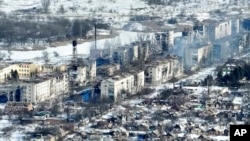Russia’s invasion of Ukraine one year ago has sparked a long-term transformation across European defenses, a top U.S. general told VOA, as the Pentagon warns that Moscow has “already lost” its fight to control Ukraine.
“The security environment here in Europe has been changed for decades,” Lieutenant General John Kolasheski, commander general of V Corps who is responsible for U.S. Army operations along NATO’s eastern flank, said in an exclusive interview in Poland earlier this month.
As Russia’s war efforts took shape, the United States poured thousands of additional troops into Europe while European nations close to the conflict ramped up defense spending.
“This is something that all of our allies and partners take as a real threat, and the cohesion here has been greater than I’ve ever seen,” he said.
Washington has spent tens of billions of dollars on military support for Ukraine, as has the rest of NATO combined.
Estonia and Latvia, which border Russia, have spent at least 1% of their GDPs on Ukrainian aid. Estonian Defense Minister Hanno Pevkur told VOA that Estonia’s self-defense expenditure had increased to 2.8% this year and would reach 3.2% of GDP next year.
“We have a clear understanding that every tank destroyed in Ukraine is one tank less behind our border,” he said.
However, polls have shown American public support for providing weapons to Ukraine has dipped from 60% in favor last May, to 48% now. There’s also been a modest erosion in congressional support for Ukrainian war spending.
Most of that erosion comes from “a vocal minority of Republicans,” according to Bradley Bowman, a veteran who is senior director of the Center on Military and Political Power at the Foundation for Defense of Democracies.
U.S. security spending for Ukraine is about $30 billion, which Bowman said is about 3.5% of the entire defense budget this fiscal year.
“So, what are we getting for that 3.5%? I would say that we're preventing Russian President [Vladimir] Putin from accomplishing many of his objectives in Ukraine. We're sending a very important message around the world that America is not neutral and will not sit on its hands when an autocratic bully tries to redraw international borders with military force … without a single American soldier in harm's way,” he told VOA on Thursday.
Russia had controlled as much as 25% of Ukraine last year before Kyiv’s forces quickly waged a counterattack.
Now, Russian-controlled territory has been whittled to 18%, with Western officials and former officials hoping that Ukraine will be able to punch through hardened Russian defenses as new advanced weaponry arrives in Ukraine, including German-made Leopard 2 tanks and British-made Challenger 2 tanks.
“The battles in Ukraine will be slow, and what you need is, you need a heavy tank like Challenger that can take a hit,” said Major Nick Bridges, the U.K. chief of staff of Estonia’s Enhanced Forward Presence Battlegroup. He added that these tanks can sustain multiple attacks, while the Soviet-era T-72 tanks that Ukrainians forces currently use “will probably be destroyed after one round.”
As Russia has shown signs of a fresh offensive in Ukraine, U.S. officials have described Moscow’s tactics as akin to “tossing bodies into a meat grinder.”
“I kind of call it the ‘Bakhmutization’ of the conflict, where they are literally throwing hundreds of lives away every single day to make incremental gains that are not strategically important,” said Colin Kahl, undersecretary of defense for policy, referring to the brutal fighting for Bakhmut, where deadly battles resulted in a tug-of-war exchange of small blocks of territory.
Kahl, speaking to VOA at the Pentagon this week, said the point of sending weapons like Western tanks to Ukraine is to allow it to “fight differently” than the Russians in order to “change the dynamics of the front lines.”
He said Putin has repeatedly miscalculated over the past year, resulting in a failure to achieve Russian objectives ranging from absorbing Ukraine into the Russian empire to weakening the NATO alliance.
“One thing has actually become crystal clear, and that is Russia has already lost,” Kahl said.









